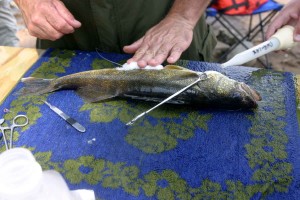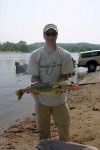GARY ENGBERG|For the State Journal | No Comments Posted | Posted: Tuesday, June 28, 2011 10:00 pm
 See the dozens of unique artificial fish habitat models, fish attractors and fish cover used at fishiding.com, the industry leader and only science based, man made and artificial fish habitat, proven to provide all fish with cover they prefer to prosper.
See the dozens of unique artificial fish habitat models, fish attractors and fish cover used at fishiding.com, the industry leader and only science based, man made and artificial fish habitat, proven to provide all fish with cover they prefer to prosper.A walleye’s gills are watered after its stomach was stitched to hold a radio transmitter.
The Wisconsin Department of Natural Resources is constantly doing research on the rivers and lakes in the state.
When you consider the thousands of lakes and thousands of miles of shoreline on the state’s rivers, the DNR has a never-ending job in keeping our waters clean — free of pollutants, protecting our resources and providing good fishing opportunities to the million and a half anglers who purchase resident and non-resident licenses.
Every spring, I go on to area lakes with DNR technicians as they electro-fish and fyke net fish on the Madison Chain of Lakes. The Madison lakes are regularly netted and shocked every five years for information and data on each lakes fishery and what is planned for the future in stocking and fish species.
For example, some of the research is the stocking of the Leech Lake muskie strain and the Wisconsin or Thompson muskie strain in local lakes to see which muskie does better in our waters and what muskie strain stocking is better economically. Much of the research being done will not produce results for years with the relatively slow growth of the muskie.
Recently, I happened to be up near the Prairie du Sac Dam on the Wisconsin River doing some wading for smallmouth bass. Near the VFW boating landing, I ran into Dr. Brian Weigel, a DNR fisheries researcher from the DNR Science Services Department, and Kurt Welke, DNR fish biologist and manager.
They were on the Wisconsin River researching the temperature preference of walleyes because the river’s temperature is now near the thermal preference threshold for walleyes. Many scientists and researchers predict that climate change will bring warmer water to the Upper Midwest, which may impact what fish species will inhabit and survive.
Conditions for fish — and walleyes in particular along with their close cousin the sauger — could be difficult in the future with an increase in the river’s water temperature which is predicted to be above the fish’s comfort zone. The researchers want to know where the walleyes are going in the warmer water of summer.
The day I ran into the DNR, they had two boats with fisheries technicians and grad students electro-fishing the waters below the dam for walleyes.
The electro-fished walleyes were put into a tank and revived from the shocking. Then, Weigel and Welke would cut a slit with a scalpel along the walleye’s stomach and insert a transmitter into the abdominal cavity.
The transmitters are about the size of an AAA battery. The cut was then stitched with monofilament line and patted down with iodine to prevent infection. The walleyes were then put into a “holding tank” which had a water re-circulator to keep the fish alive and give them time to recover before being released back into the Wisconsin River.
Weigel and Welke wanted to get 25 to 30 fish near the dam for their study. They seemed to be reaching their walleye quota.
The radio transmitters that are put into the fish will show where they are “hanging out” during the warmer months of the year. Walleyes have to be at least 16 inches long and preferably longer for the transmitters — which along with the software will allow Weigel to record data for two years. The transmitters are turned off during the winter.
There may be things done in the future to enhance the walleye’s survival such as improving fish habitat and changing the river’s water flow. The Wisconsin River fishery is a valuable and very vulnerable resource which deserves all the protection and help that it needs to provide fishing and recreational activities to all.
The trees and soil along the river’s banks are falling into the river at an alarming rate. The river seems to change every year with deeper areas getting filled in with sand and silt. Once one gets past the Highway 12 Bridge at Sauk City, it is difficult to find water deeper than 10 feet. The only really deep water is directly below the dam in the “scour” hole created from high water in the spring.
Weigel and his crew also electro-fished the Lower Wisconsin River from the Highway Y boat landing to Arena and only “caught” eight fish. There seemed to be many more walleyes in the immediate area below the Prairie Dam the previous day. This may be because the fish hadn’t migrated downriver yet, the larger females were still recovering from spawning, the fish were staying near the dam because of the deep water, or the fish were gorging on forage fish.
The DNR is trying to answer these and many more questions if we are going to continue to have a walleye fishery on the Wisconsin River. But, the real question is, where do walleyes go in warmer water?
Maybe they’ll go to the Mississippi River or do they cease to exist in the warmer river?
Only time will tell, but at least the DNR is pursuing the questions.
Contact Gary Engberg, a freelance outdoors writer, at gengberg@chorus.net, call 608-795-4208 or visit his website at http://www.garyengbergoutdoors.com.

